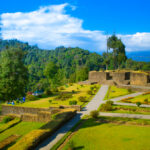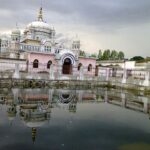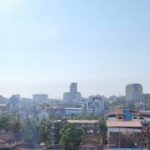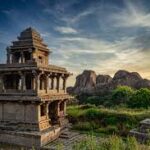Now Reading: Top 5 Best Places Visiting in Gaya for Spiritual Journeys & Heritage
-
01
Top 5 Best Places Visiting in Gaya for Spiritual Journeys & Heritage

Top 5 Best Places Visiting in Gaya for Spiritual Journeys & Heritage
1. Muchalinda sarovar
The Lotus Pond known as Muchalinda Sarovar serves as a sacred and peaceful location in the town of Bodh Gaya situated in Bihar. This holy pond maintains deep spiritual worth for Buddhist pilgrims and worldwide visitors because its history embraces significant aspects of Lord Buddha’s life and enlightenment revelation. Religious traditions show that Lord Buddha spent the sixth week of meditation at this place after attaining enlightenment under the Bodhi Tree.
This piece will examine both the historical development and spiritual importance along with the typical visitor experience of Muchalinda Sarovar.
Visitors discover this peaceful location serves as their meditation retreat because it uses a symbolic statue to create a space that fosters spiritual connection and tranquility.
Through Buddhist belief the Pond of Tortoise King Muchalinda maintains great spiritual importance. Buddha’s enlightenment received protection from Muchalinda because nature showed reverence towards his enlightenment while representing the strength of meditation and inner peace. Today Muchalinda Sarovar attracts people who practice devotion while experiencing meditation and reflective activities.
Visitors find a peaceful atmosphere at this site because of the pond’s reflections combined with floating lotus blossoms and Buddha’s statue. This creates an ideal area for people who wish to find mindfulness and peace.
Meditation and reflection become possible when one visits the peaceful Muchalinda Sarovar because of its serene atmosphere. The pond area provides seats where people can experience complete peace while enjoying the tranquil surrounding.
Viewers can admire at the Buddha Statue which beautifully captures Buddha during his conversation with Muchalinda. Carefully consider the detailed craftsmanship used in the statue through careful observation of its complex design elements.
The pond contains various vibrant fishes that bring joy to visitors because they observe them performing their graceful underwater movements. The surface of the water shines with poetic beauty because of the lotus blossoms that drift among its tranquil waters.
Photos of Muchalinda Sarovar should feature its picturesque surroundings including the Buddha statue enclosed by lush vegetation surrounding lotus blooms.
Best Time to Visit Muchalinda Sarovar
Visitors should plan their journey to Muchalinda Sarovar for the winter season from October through March because of its comfortable and mild climate. Visitors can maximize their enjoyment during the winter months between October and March because they can discover the sacred sites while also experiencing the serene feelings of the pond.
The Buddhist celebration of Buddha Purnima transforms Bodh Gaya together with Muchalinda Sarovar into a site where followers from all regions of the world attend religious services while conducting devotional rituals.
Visitor Tips
Visitors should treat Muchalinda Sarovar with respect by implementing both silence and modest dress standards while they prevent littering of the site.
Daytime travelers should always bring water with sunscreen as well as a hat because of hot summer conditions.
Explore Muchalinda Sarovar by getting a nearby guide to learn about its historical background.
The litany of essentials should include photographic documentation of the pond and its lotus blossoms along with the Buddha statue.
2. Vishnupad Temple
The Vishnupad Temple finds its location within the historical city of Gaya in the state of Bihar and serves as a vital Hindu pilgrimage destination. The temple rests alongside the divine Phalgu River which possesses strong religious and historical and cultural value. Lord Vishnu receives worship at this temple because it honors the rock where his eternal footprint remains visible. People from different parts of India frequent this temple as performing Pind-Daan is among the sacred activities they do for dead relatives.
This article investigates the historical background and essential characteristics of Vishnupad Temple that establishes it as an essential holy destination for travelers.
History
The reconstruction of the Vishnupad Temple took place during 1787 when Queen Ahilyabai Holkar dedicated it to restoration tasks that included the Kashi Vishwanath Temple in Varanasi as well as the Mahakaleshwar Temple in Ujjain. Queen Ahilyabai Holkar ruled the Maratha Empire with kindness while restoring numerous Hindu temples. Her profound devotion to Hindu traditions and her dedication are visible in the magnificent architectural elements of the temple.
The site of worship has been present since ancient era and its name Vishnupad signifies “Vishnu’s footprint.” The Hindu legend explains how Lord Vishnu fixed his footprint into the rock after defeating the demon Gayasura because the deity stepped on the offender to end his harmful activities against Earth’s people. Through his divine action Lord Vishnu pushed down the demon until he sank into the earth whereupon the deity liberated Earth from its suppression. The story suggests that this act formed the substantial footprint-shaped hole that became vital for the sanctum of the temple.
One remarkable feature of the Vishnupad Temple stands out as a representation of Nagara-style Hindu temple architecture through its elevated shikharas combined with elaborate decorative artwork. The establishment stands completely as gray granite construction which displays elaborate carvings alongside script quadrants and aesthetic embellishments that represent its cultural history.
The Vishnupad Temple maintains strong connections with the Pind-Daan ritual whereby Hindus perform this ritual to free their deceased ancestors. The Hindu belief states that performing Pind-Daan rituals at Gaya releases departed souls from reincarnation unlocking eternal tranquility for them.
Lord Rama led Sita and Lakshmana to Gaya in the Ramayana while they conducted Pind-Daan to honor their king Dasharatha. The temple stands documented in both ancient records from the Mahabharata as well as from the Ramayana.
Festivals and Events
During particular festivities along with religious celebrations the temple welcomes numerous visitors due to its heightened spirit.
Best Time to Visit
Visitors should explore both the temple and adjacent sights at Vishnupad Temple during October through March since this period provides the most comfortable atmosphere with nice weather. The temple welcomes an overwhelming number of worshippers during Pitru Paksha (September-October) because of the Pind-Daan religious ceremonies.
Visitor Tips
- The temple demands silent behavior from visitors while the proper religious dress ensures appropriate respect to sacred spiritual emotions inside the temple complex.
- People planning Pind-Daan should receive guidance from temple priests regarding proper religious procedures.
- From a desire for personal privacy it is advisable to schedule your visit to the temple outside times of high crowds during religious festivities.
- Before photographing inside the sanctum consult temple authorities to determine their restrictions on picture-taking.
3. Sujata stupa

The historical Sujata Stupa exists in the quiet village of Senanigrama (Bakraur) which rests close to Bodh Gaya in Bihar. This historic landmark memorializes Sujata’s noble actions as she provided food to Gautama Buddha on his path to becoming the enlightened Buddha. Travelers interested in history along with pilgrims and spiritual seekers should make Sujata Stupa one of their destinations because it offers profound historical importance accompanied by spiritual charm and archaeological significance.
This piece investigates Sujata Stupa through its historical background together with famous stories and architectural details and visitor guidelines to support your understanding of the ancient site.
The Legend of Sujata and the Turning Point in Buddha’s Life
History tells how Sujata Stupa gained its relevance because of Gautama Buddha’s transformative moment. The path to enlightenment for Buddha involved six years of intense self-death by starvation and physical hardship which he believed would bring him spiritual enlightenment. His intense practice resulted in physical collapse through wasting away and weakening of his body.
The Buddhist story tells that Sujata a compassionate milkmaid from Bakraur village observed Buddha sitting under the Banyan tree at the Phalgu River and felt sympathy for his weak state. Buddha accepted the bowl of kheer (sweetened rice pudding) that Sujata provided him. The compassionate gesture from Sujata enabled Buddha to regain his strength and caused him to leave behind asceticism therefore leading him to discover the Middle Path as his path to enlightenment.
After the meeting Buddha went to meditate under the Bodhi Tree at Bodh Gaya where he found enlightenment. The Sujata Stupa stands at the kheer-sharing location where Buddha received his food from Sujata as a token of remembrance for her transformative gesture.
History
The Sujata Stupa stands among the oldest Buddhist sites in the region as it was built in the 2nd century BCE. The continuous respect for Sujata’s charitable deed led to years of expansion and restoration of the monument. A pillar from Ashoka originally stood at the stupa as a sacred symbol.
In 1973-74 and a second time from 2001-06 the Archaeological Survey of India (ASI) conducted excavations at the site which revealed numerous historical artifacts and critical inscriptions related to the stupa.
Best Time to Visit
Visitors should plan their trip to Sujata Stupa during winter from October to March because the weather remains cool and pleasant at that time. The location reaches maximum liveliness during both Buddhist holidays and special celebrations.
4. Tapovan
The sacred hot water springs in Tapovan located close to Rajgir within the Nalanda district of Bihar draw spiritual pilgrims because believers see them as sources of divine healing. The place Tapovan rests within a pretty landscape which is embraced by hills and rich vegetation while retaining an important religious value. Physically bathing within these hot springs is connected to Lord Buddha who supposedly spent time there allowing the site to gain religious value. Throughout history numerous devotees together with travelers have come to Tapovan in order to bathe in its authentic natural hot springs which both heal chronic medical conditions and purify the soul.
This article investigates the holy heritage of Tapovan by examining its religious traditions and highlights various destinations in addition to giving travel recommendations to those planning visits.
History
The combination of Sanskrit terms “Tapas” and “Vana” produces the name “Tapovan” that means forest of penance. The site earned its name because humans have practiced meditation and spiritual practices in Tapovan since ancient times.
The history of Tapovan relates to both Lord Buddha and King Bimbisara from Magadha. Buddhist texts show that Lord Buddha met King Bimbisara at Yesthivana (Jethian today) near Tapovan while allowing the king to become one of his initial disciples. During the 7th century Buddhist pilgrim Hiuen Tsang visited Tapovan describing it as a religious site featuring two natural hot springs which Buddha supposedly appeared before.
During his journey from Gaya to Rajgir Lord Buddha is said to have bathed in the hot water springs that exist in Tapovan. The holy water in which Buddha bathed provided spiritual power to the sources that refreshed people. News about the spiritual power of these holy waters spread rapidly enabling various communities from different areas to visit Tapovan which treated their diseases and cleaned their souls. The same healing practice from centuries ago has brought people continuously to Tapovan where they still search for medical and religious therapy.
Natural hot water springs at Tapovan are what draw most visitors to this location. The thermal springs contain minerals with sulfur as the main component that people believe shows therapeutic potential. People who bathe in the thermal pools claim it helps both their skin conditions and joint disease symptoms along with managing different persistent health conditions. People who visit this site report that it provides them both mental and religious strength.
Geological activities beneath the earth surface generate the hot water springs at Tapovan. When underground water touches heated deep rocks beneath the Earth it receives heat that creates natural hot springs by rising to the surface. High minerals present in the water produce therapeutic characteristics.
The therapeutic facility at Tapovan functions both as physical healing sanctuary and holy location of spiritual renewal. The environment at Tapovan provides optimal conditions for spiritual exploration because its natural hill and forest surroundings create peaceful harmony. Buddhist monks and sages along with spiritual seekers traveled to Tapovan to practice meditation for reaching their inner consciousness through history. The place maintains its tranquil atmosphere which draws spiritual visitors along with pilgrims who travel from various corners of the world.
Best Time to Visit Tapovan
Winter months from October through March prove to be the ideal period to explore Tapovan because they provide excellent weather conditions for both touring and spiritual activities and hot spring bathing. During the monsoon months from June to September the region becomes more attractive yet visitors might face difficulties reaching the springs because of wet conditions.
5. Mangla Gauri Hill

The beloved Mangla Gauri Temple exists within India as one of its most revered and historical places which stands on Mangla Gauri Hill in Gaya Bihar. The temple sustains utmost importance to Hinduism because it stands among the 52 Mahashakti Peethas devoted to Goddess Sati. Legend states the temple site contains the breast part of Goddess Sati which shattered off when Lord Vishnu attacked her body with his Sudarshan Chakra. People recognize the temple as an emblem of caring spirit together with maternal love and financial success.
This blog shares a spiritual exploration of Mangla Gauri Temple’s history combined with its religious traditions and distinctive practices as well as its profound importance for devotees.
History
The Mangla Gauri Temple has existed since the 15th century and its origins appear in the Padma Purana and Vayu Purana among other Hindu scriptures that include Agni Purana and Markandeya Purana and Sri Devi Bhagavata Purana. Goddess Sati chose to burn herself in her father Daksha’s religious fire before Lord Shiva carried her dead body across all of space during his state of mourning and destructive grief. Lord Vishnu cooled down Lord Shiva by using his Sudarshan Chakra to cut apart Sati’s body. The landing spots of her body segments resulted in the creation of sacred locations called Shakti Peethas.
Mangla Gauri Hill received the falling breast of Goddess Sati and emerged as a Shakti Peetha which welcomes numerous pilgrims and devotees for spiritual fulfillment.
Best Time to Visit
The most favorable period to visit Mangla Gauri Temple falls between October and March since the climate remains pleasant throughout these winter months. The Navratri festival stands out as an ideal period to visit the temple because it turns into a vibrant scene where devotees gather for their devotional enthusiasm during the festivities.
Related articles : Best Places Visiting in Karbi Anglong for Nature, Culture & Adventure
Stay Informed With the Latest & Most Important News
Previous Post
Next Post
-
 01Top 5 Best Places Visiting in Gyalshing – Monasteries, Lakes & Scenic Escapes
01Top 5 Best Places Visiting in Gyalshing – Monasteries, Lakes & Scenic Escapes -
 02Top 5 Best Places Visiting in Panna – Temples, Waterfalls & Wildlife Escapes
02Top 5 Best Places Visiting in Panna – Temples, Waterfalls & Wildlife Escapes -
 03Top 5 Best Places to Visit in Malerkotla – Malerkotla Fort, Sheesh Mahal & More
03Top 5 Best Places to Visit in Malerkotla – Malerkotla Fort, Sheesh Mahal & More -
 04Top 10 Best Places Visiting in Dakshina Kannad for Culture, Nature & Coastal Charm
04Top 10 Best Places Visiting in Dakshina Kannad for Culture, Nature & Coastal Charm -
 05Top 2 Best Places Visiting in Chitradurga for History, Nature & Adventure
05Top 2 Best Places Visiting in Chitradurga for History, Nature & Adventure -
 06Best Places Visiting in Shopian – Explore Top Attractions & Hidden Gems
06Best Places Visiting in Shopian – Explore Top Attractions & Hidden Gems -
 07Best Places Visiting in Narmadapuram – Temples, Waterfalls & Wildlife Escapes
07Best Places Visiting in Narmadapuram – Temples, Waterfalls & Wildlife Escapes














Pingback: Best Place Visiting in Gopalganj – Explore Bihar's Hidden Gem